Plants Detail's
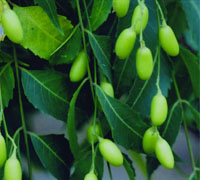
Neem (Azadirachta indica)
The commercial value of neem has been known to mankind since time immemorial. Each part of the tree like the bark, seed, leaf, flower, wood, twig has been in use in
the traditional systems of medicine and now, it is being used on a commercial basis for large scale production of medicines, pharmaceuticals, cosmetics, pesticides,
manures, animal feed. Neem is considered to be a renewable source of various useful products. Several derivatives obtained from neem fruits, neem leaves - a storehouse
of bioactive chemicals are used in production of useful agrochemicals, toiletries etc. The revered tree has immense potential to help small and rural farmers provide
lucrative employment opportunities in developing nations. The cultivation and processing of raw neem, neem extracts and neem finished products pose big income generation
opportunities .ability. As neem can grow in areas with low productivity and dry soil, not much investment is required on small scale cultivation.//Neem and its products
are r in high demand in almost all countries like US, UK, Australia etc. A number of research funded and conducted by international organizations have established the
safety and efficacy of neem for use in medicines, pesticides, agro chemicals, animal industry etc. It is being grown on a large scale production. Neem products have shown
a good export potential which also needs to be exploited. Neem researches are being undertaken by organizations such as UN to see if it can be used as a bio fuel,
particularly to manufacture bio diesel.
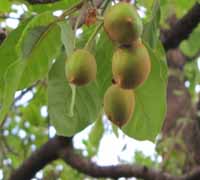
Mahua (Madhuca longifolia)
The tree is of multiple uses to the local inhabitants for its leaves, flowers, fruits and bark furnish forest produce of commercial importance.
The fleshy corollas are edible as they are a rich source of sugars, vitamins, calcium and essential oil. Flowers are largely used for preparation
of country made distilled liquor. The seed kernel yields 5.1% of fatty oil which constitutes “Mohwa oil or butter of commerce”. The oil is used
in cooking, for burning in lamps, in the manufacture of margarine and soap and many other minor uses. The oil cake is used as a fertilizer. ,.
There is a great scope for expanding industrial units to tap non-edible propertiesof this species. The timber can be put to a variety of uses
such as building purposes as beams, door and window frames, posts etc. It is suitable for heavy work such as bridges, pile, sugar presses,
cart wheels, ships, boats, sport goods, furniture etc. When seasoned it is suitable for agricultural implements, drum and carving. It is a good
fuel wood. The flowers can also be fed to the livestock. The outer part of the fruit is eaten raw or cooked and the inner part is made into flour
for cakes. The leaves yield fodder of medium quality and are lopped in M.P. Maharashtra, Orissa and U.P. at the times of scarcity. Its seeds are
good feedstock for biodiesel industry.
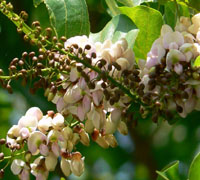
Karanj (Pongamia pinnata)
Seed oil is applied externally for itching and is used as an antiseptic and anti fungal. it is grinded with black pepper and used given malarial fever. Root juice is
applied in sinus ulcers and non healing ulcers. Flowers are used in diabetes internally and externally in alopecia. Karanja seeds used with camphor help to check diseases
like scabies, eczema, ringworm infestation etc. Poultice paste of leaves applied on wounds helps to relieve pain and swelling of the wounds. In chronic sinusitis, powder
of leaves of karanja plant taken through nose gives relief. Applying mash of pulp of karanja flowers on head helps to check alopecia. Ghee prepared with bark of
karanja is useful in diseases like syphilis and gonorrhea. Used with neem, guduchi and arishtak ,karanja helps to check skin diseases. Bath with leaves boiled in water
is useful in arthritis. Its use is indicated in piles, tumors, worm and wounds. It helps in breaking the accumulation of fecal matter and acts a purgative. Its use has
also been indicated in checking obesity. The essential oil from the leaves of karanja has shown anti bacterial activity. It has shown mild fungal activity. This seeds
are the good source of raw materials to biodiesel production.
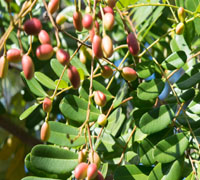
Simarouba (Simarouba glauca)
The organic manure produced from the cultivation of even just one tree of Simarouba is 20 kg from just leaf litter and pulp waste, apart from the de-oiled seed cakes. The
fruit pulp contains 11-16 per cent sugars which translate to 12,000 litres per hectare of a healthy drink or can be used to produce ethanol. Waste fruit pulp can be used
in vermicompost also. Seed shell can be used in manufacturing particle board and activated charcoal, apart from being a good fuel which leaves behind an ash rich in potash.
The seeds contain 60-75 per cent oil, the highest from any plant which means a yield of anywhere between 1,000—2,000 kg of oil per hectare. The edible oil from Simarouba
tree is the only plant source of top quality vegetable butter. Timber from tree is light, moderately strong, attractively grained and can be used to manufacture household
furniture and other products. It can be harvested by as early as six years. Simarouba has 11 medicinally important quassinoids, the active principles in the tree, that
have antimicrobial properties and four quassinoids namely ailanthinone, glaucarubinone, dehydroglaucarubinone and holacanthone that are anti-luekemic and anti-cancerous.
All illnesses caused by microbes like bacteria, viruses, protozoa like Chikungunya, hepatitis, herpes, malaria, viral coughs and colds, dental caries, gastritis caused
by helicobacter pylori and rheumatoid arthritis can be effectively cured by consumption of a decoction made from leaves and bark of the tree. The anti-cancerous properties
of the extract can cure I and II stage cancer and improve the quality of life in the III and IV stages. It is a boon for women with menstrual problems as well. Many of
his patients report a complete recovery or drastic improvement from various conditions such as gastritis from H.pylori, acidity, rheumatoid arthritis, cancers of the
mouth, lungs, ovaries, breast and various menstrual problems. A 60ml Simarouba extract is sold for $23 in the West. Simarouba based sustainable, rural industries like
furniture, beverages, cosmetics (juice is an excellent skin conditioner) like soaps, skin creams, vermicomposting, biofuels, edible oil can flourish, improving the
quality of life for the people, in both, rural and urban areas.
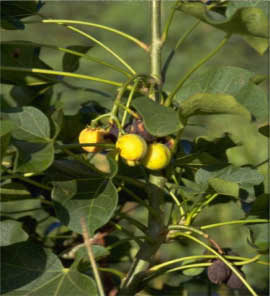
Jatropha (Jatropha curcas)
Jatropha is a valuable multi-purpose crop to alleviate soil degradation, desertification and deforestation, which can be used for bio-energy to
replace petro-diesel, for soap production and climatic protection, and hence deserves specific attention. Jatropha can help to increase rural
incomes, self-sustainability and alleviate poverty for women, elderly, children and men, tribal communities, small farmers. It can as well help
to increase income from plantations and agro-industries. The non edible vegetable oil extracted from the Jatropha plant can be used as an alternative
to the diesel oil. The jatropha oil has advantageous physicochemical and the characteristic that is equal to diesel. So cars can use this oil
with little change in their design. The oil can be used as an illuminant without refining. The jatropha oil burns with clear free smoke and flame.
Because of its high saponification the oil is used to make soap in some parts of the world. Jatrophine an alkaloid material is present in the
latex of jatropha which is assumed to have anti cancerous properties. It is used on the domestic livestock for skin diseases, sore and rheumatism.
The tender wing of the jatropha plant is used for cleaning. The juice of the leaf is used for piles as an external application. The roots are
believed to act as an antidote for snake bites. A dark blue dye is extracted from the bark of jatropha. This dye is used as a colouring matter
for clothes, fishing nets, and lines. Jatropha oil cake is used as organic manure since it is rich in potassium, phosphorous, and nitrogen.
Silkworms consume the leaves of the jatropha leaves for their diet. Jatropha oil is used as a lubricant for machinery and is also used to soften
leather. Apart from the above uses the main use of the jatropha land is that it turns the waste land into money making one. Thus increasing the
income and lessening the poverty for women and children of small farmer families.